





Everything For The Detectorist - Reference & Timelines

Powered By Sispro1

Geological Periodical Table
Designed by Nigel G Wilcox
Copyright All Rights Reserved by Nigel G Wilcox E-Mail: ngwilcox100@gmail.com
The Paragon Of Metal Detecting
& Archaeology
& Archaeology
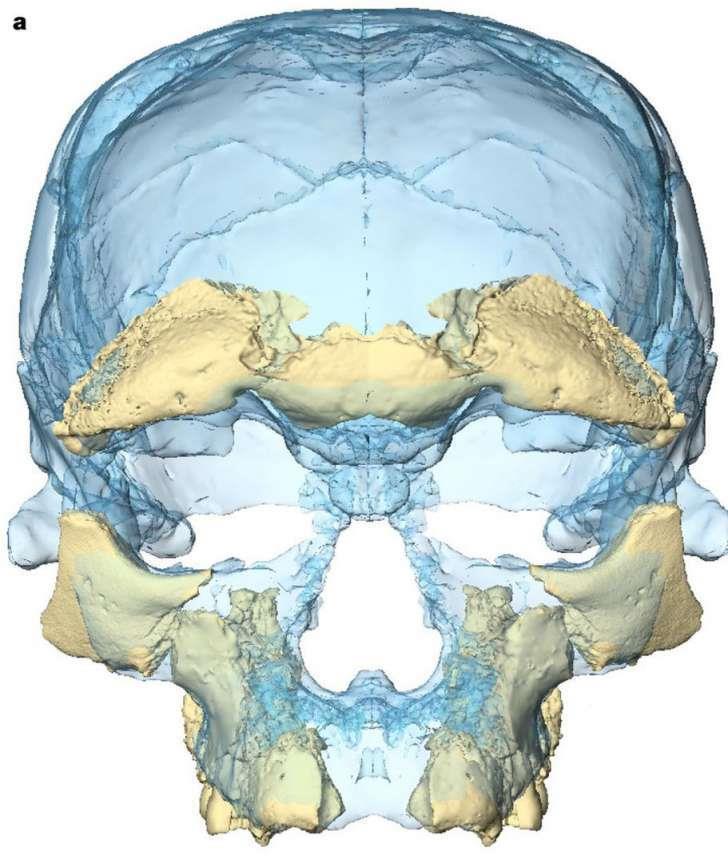
WE DISCOVERED HUMANS ARE 100,000 YEARS OLDER THAN WE THOUGHT.
© Provided by The Week Publications facial reconstruction of 300,000-year-old skull found in Morocco
Until this year, modern humans were thought to have originated between 150,000 and 200,000 years ago, according to the oldest-known fossils of Homo sapiens found in Ethiopia. But recently unearthed remains of five early H. sapiens were dated at 300,000 years old, making our species 100,000 years older than we thought.
The new fossils were found in Morocco, on the other side of the African continent and further north than Ethiopia. Researchers now think that our ancestors may not have originated in any one specific spot in Africa, but rather evolved across the entire continent.
Before the Sahara became a desert, it sprouted forests and plains, making it possible for early humans to travel across the continent. The early hominids were likely following and hunting herds of gazelles or other animals, evolving new cognitive skills along the way, which enabled them to create more complex tools and develop advanced social behaviors. So as they spread across Africa, these early humans acquired the very traits that later came to define our species.
Courtesy: msn.com, Mental Floss - Leina Zeldovich 24.12.17
The new fossils were found in Morocco, on the other side of the African continent and further north than Ethiopia. Researchers now think that our ancestors may not have originated in any one specific spot in Africa, but rather evolved across the entire continent.
Before the Sahara became a desert, it sprouted forests and plains, making it possible for early humans to travel across the continent. The early hominids were likely following and hunting herds of gazelles or other animals, evolving new cognitive skills along the way, which enabled them to create more complex tools and develop advanced social behaviors. So as they spread across Africa, these early humans acquired the very traits that later came to define our species.
Courtesy: msn.com, Mental Floss - Leina Zeldovich 24.12.17
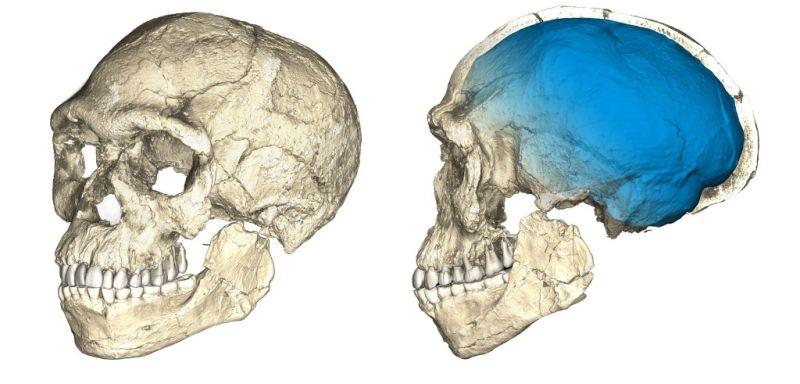
Two views of a composite reconstruction of the earliest known Homo sapiens fossils from Jebel Irhoud (Morocco) based on micro computed tomographic scans of multiple original fossils. (Credit: Philipp Gunz, MPI EVA Leipzig)
The remains of five early Homo sapiens have been unearthed at a site in northwest Africa. At around 300,000 years old, the fossils are a whopping 100,000 years older than the previous record, pushing back the origin of our species by a significant margin. And because the fossils were uncovered in Morocco—far from the supposed origin point of our species—the discovery is also resetting our notions of where and how modern humans evolved. The origin of our species is shrouded in mystery owing to the poor fossil record and a complete dearth of genetic evidence.
The surprising discovery of the fossilized remains of five early humans at a site in Jebel Irhoud, Morocco along with evidence of stone tools, animal bones, and use of fire is adding an important piece to this frustratingly incomplete archaeological puzzle. As this discovery shows, our species, known in the scientific nomenclature as Homo sapiens, has been around for a lot longer than we realized a hundred thousand years longer, to be precise. We can now say, with reasonable confidence, that the species to which you and I belong to emerged in Africa around 300,000 years ago. It s conceivable, of course, that archaeologists may find older specimens in the future, but this now the upper bound for the start date of H. sapiens.
What s more, our species didn t originate from a confined area of Africa, but rather, across the entire continent. As study co-author Jean-Jacques Hublin of the Max Planck Institute for Evolutionary Anthropology explained at a press conference yesterday, There is no Garden of Eden in Africa, because the Garden of Eden is Africa. Early bipedal hominids from which we re descended may have emerged from the African interior, but the evolutionary drivers that created H. sapiens were in place across the entire continent, and in northwest Africa in particular. These conclusions now appear in two separate studies, both published today in the science journal Nature. In the first paper, the scientists describe the fossils found at the site; in the second, they analyze and date the stone tools.
Before this new discovery, the oldest known samples of H. sapiens were uncovered in Ethiopia, and dated to between 150,000 to 200,000 years old. Strangely, however, Neanderthals and archaic Homo sapiens (i.e. humans that immediately pre-date H. sapiens, and who lived between 300,000 and 150,000 years ago) diverged from a common ancestor around 500,000 to 600,000 years ago. The lack of fossil evidence prior to 200,000 years ago led some scientists to theorize that H. sapiens must have emerged rather suddenly, likely from a predecessor species known as Homo heidelbergensis. (As an aside, any hominid with the word Homo in front of it is considered a human).
The surprising discovery of the fossilized remains of five early humans at a site in Jebel Irhoud, Morocco along with evidence of stone tools, animal bones, and use of fire is adding an important piece to this frustratingly incomplete archaeological puzzle. As this discovery shows, our species, known in the scientific nomenclature as Homo sapiens, has been around for a lot longer than we realized a hundred thousand years longer, to be precise. We can now say, with reasonable confidence, that the species to which you and I belong to emerged in Africa around 300,000 years ago. It s conceivable, of course, that archaeologists may find older specimens in the future, but this now the upper bound for the start date of H. sapiens.
What s more, our species didn t originate from a confined area of Africa, but rather, across the entire continent. As study co-author Jean-Jacques Hublin of the Max Planck Institute for Evolutionary Anthropology explained at a press conference yesterday, There is no Garden of Eden in Africa, because the Garden of Eden is Africa. Early bipedal hominids from which we re descended may have emerged from the African interior, but the evolutionary drivers that created H. sapiens were in place across the entire continent, and in northwest Africa in particular. These conclusions now appear in two separate studies, both published today in the science journal Nature. In the first paper, the scientists describe the fossils found at the site; in the second, they analyze and date the stone tools.
Before this new discovery, the oldest known samples of H. sapiens were uncovered in Ethiopia, and dated to between 150,000 to 200,000 years old. Strangely, however, Neanderthals and archaic Homo sapiens (i.e. humans that immediately pre-date H. sapiens, and who lived between 300,000 and 150,000 years ago) diverged from a common ancestor around 500,000 to 600,000 years ago. The lack of fossil evidence prior to 200,000 years ago led some scientists to theorize that H. sapiens must have emerged rather suddenly, likely from a predecessor species known as Homo heidelbergensis. (As an aside, any hominid with the word Homo in front of it is considered a human).
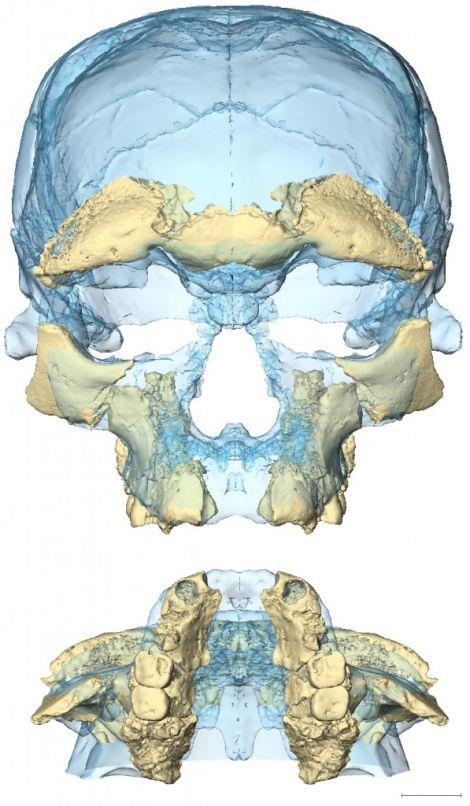
This new discovery, which shows that an early version of H. sapiens was hanging out in northwest Africa some 300,000 years ago, now challenges this “rapid emergence” theory. After diverging from a common ancestor, a group of archaic H. sapiens spread across Africa, gradually acquiring the traits that would eventually come to characterize our species.
To reach this conclusion, the authors of the new study combined new and old fossil evidence. Back in the 1960s, human fossils were found at the same site in Jebel Irhoud alongside some animal bones. The fossils were originally dated at around 40,000 years old, and the remains were thought to be some form of African Neanderthal. Unsatisfied with this interpretation, researchers from the Max Planck Institute for Evolutionary Anthropology and the National Institute for Archaeology and Heritage in Morocco decided to renew the investigation, which involved new excavations at the Moroccan site. This led to the discovery of the partial skeletal remains of five individuals—three adults, one adolescent, and one child—along with stone tools, animal bones, and signs of fire use. The archaeologists had stumbled upon an ancient cave used by early humans to process and consume animal meat, primarily gazelles and zebras. And yes, the original archaeologists missed these five specimens—but in all fairness, the digs were in-and-around a mine, which is now a giant quarry.
Using a technique known as thermoluminescence, the researchers dated the objects uncovered at the site to between 300,000 and 350,000 years old, and used the stone tools to date the fossils found in and among these artifacts. It’s now considered the oldest evidence ever found of the earliest members of the H. sapiens lineage.
To reach this conclusion, the authors of the new study combined new and old fossil evidence. Back in the 1960s, human fossils were found at the same site in Jebel Irhoud alongside some animal bones. The fossils were originally dated at around 40,000 years old, and the remains were thought to be some form of African Neanderthal. Unsatisfied with this interpretation, researchers from the Max Planck Institute for Evolutionary Anthropology and the National Institute for Archaeology and Heritage in Morocco decided to renew the investigation, which involved new excavations at the Moroccan site. This led to the discovery of the partial skeletal remains of five individuals—three adults, one adolescent, and one child—along with stone tools, animal bones, and signs of fire use. The archaeologists had stumbled upon an ancient cave used by early humans to process and consume animal meat, primarily gazelles and zebras. And yes, the original archaeologists missed these five specimens—but in all fairness, the digs were in-and-around a mine, which is now a giant quarry.
Using a technique known as thermoluminescence, the researchers dated the objects uncovered at the site to between 300,000 and 350,000 years old, and used the stone tools to date the fossils found in and among these artifacts. It’s now considered the oldest evidence ever found of the earliest members of the H. sapiens lineage.
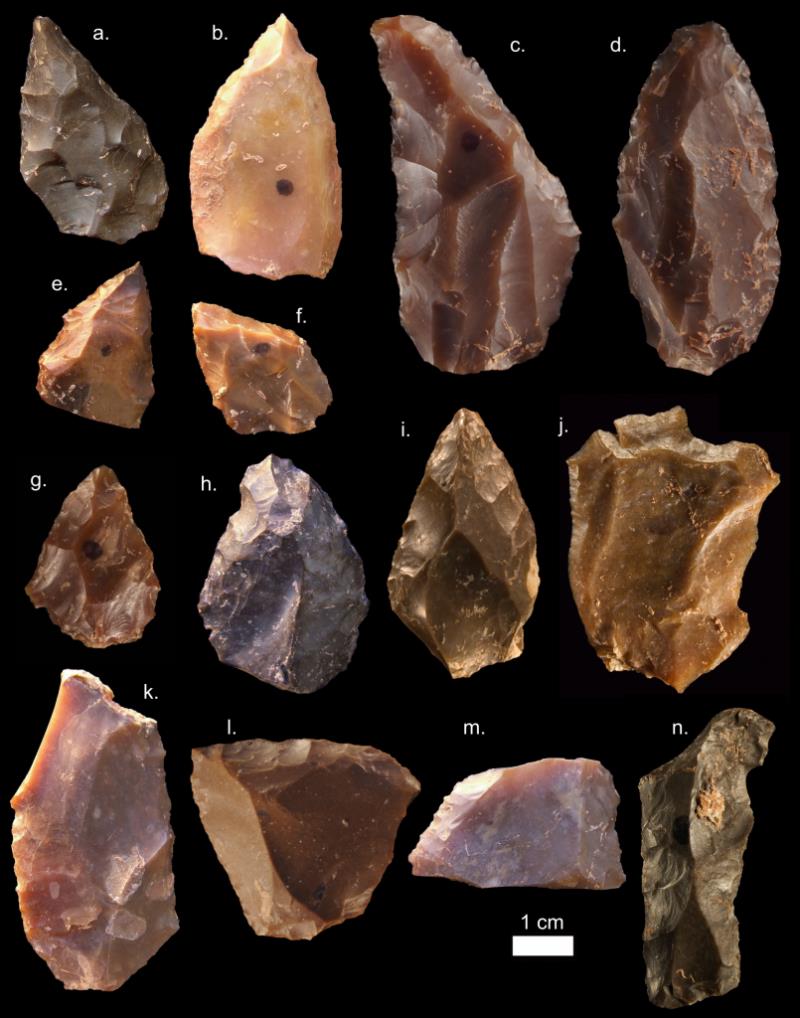
Some of the Middle Stone Age tools found at the site. (Credit: Mohammed Kamal, MPI EVA Leipzig)
Importantly, this discovery shifts the geographical origin of our species away from the interior parts of Africa. Hundreds of thousands of years ago, the Sahara was filled with forests and vast plains, making it possible for early hominids to traverse northwards towards what is now Morocco. In the case of these early H. sapiens, they were likely following herds of gazelles as they migrated across Africa, evolving new cognitive skills along the way—cognitive skills that enabled them to create more sophisticated tools and adopt complex social behaviors. By spreading across most of Africa, these hominids acquired the very traits have come to define our species.
Curtis W. Marean, an expert on human origins at Arizona State University who wasn’t involved with the study, says the new discovery is important, and not entirely surprising.
“The previous age estimate on the Jebel Irhoud hominin never made sense, for two reasons”. “First, the morphology was too primitive for the relatively young age, and second...evidence...suggested that the Maghreb was abandoned during a time when it was almost certainly very arid. So this older age makes a lot of sense. I am happy to see this team solve this problem.”
Marean says the fossils bear a striking resemblance to a distinctly human-like skull, called the Florisbad skull, discovered in South Africa back in 1932. “The similarity to [this] specimen suggests that at this time there was a pan-African population that perhaps was the same species,” he said. “This is important to know, but perhaps not unexpected.”
Curtis W. Marean, an expert on human origins at Arizona State University who wasn’t involved with the study, says the new discovery is important, and not entirely surprising.
“The previous age estimate on the Jebel Irhoud hominin never made sense, for two reasons”. “First, the morphology was too primitive for the relatively young age, and second...evidence...suggested that the Maghreb was abandoned during a time when it was almost certainly very arid. So this older age makes a lot of sense. I am happy to see this team solve this problem.”
Marean says the fossils bear a striking resemblance to a distinctly human-like skull, called the Florisbad skull, discovered in South Africa back in 1932. “The similarity to [this] specimen suggests that at this time there was a pan-African population that perhaps was the same species,” he said. “This is important to know, but perhaps not unexpected.”
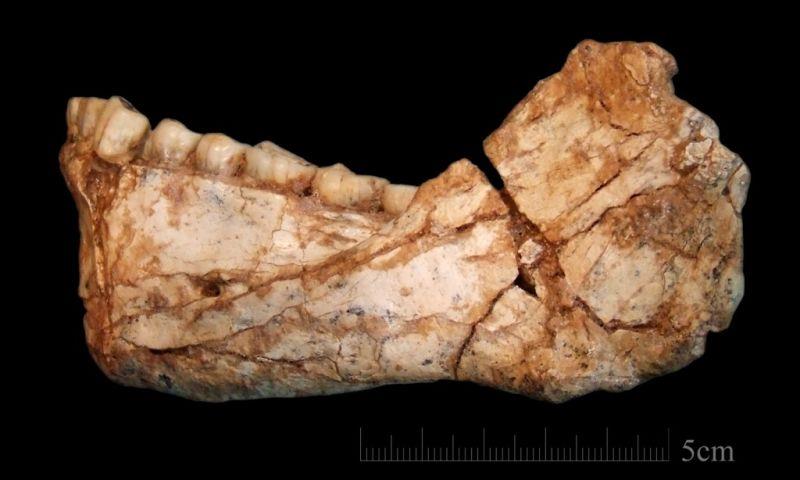
An almost complete mandible of an ancient adult H. sapiens. (Credit: Jean-Jacques Hublin, MPI-EVA, Leipzig)
It’s important to point out that the term “Homo sapiens” is not analogous to the term “modern humans.” The ancient humans found in Morocco were slightly different than humans who are alive today, but these difference weren’t significant enough for the researchers to slot them into a separate species, or to brand them as yet another band of archaic H. sapiens. By making micro computed tomographic scans of the fossils, the researchers detected some primitive features, such as a longer, lower braincase, strong brow ridges, and a large face. But they also had delicate cheekbones, a distinctly modern-looking face, and teeth and jawbones that were virtually identical to H. sapiens. As Jean-Jacques Hublin pointed out at the press conference, “these people wouldn’t stand out if we were to meet them in the street.”
Archaeologist Chris Stringer from the Natural History Museum of London, who wasn’t involved in the study, says archaeologists and anthropologists should adopt a broad definition of Homo sapiens—but he didn’t always feel that way.
“I used to argue that ‘anatomically modern humans’—including fossils that essentially look like us today—are the only group that should be called Homo sapiens,” he explained to Gizmodo in an email. “Now, I think that anatomically modern humans are only a sub-group within the species Homo sapiens, and that we should recognise the diversity of forms within early Homo sapiens, some of which probably went extinct.”
Indeed, many different groups of humans existed around this time, but it was Homo sapiens who eventually prevailed, spreading out of Africa some time between 60,000 to 70,000 years ago, and then spreading further still into Asia, Australia, and North and South America. Our species is all that’s left of the various hominid evolutionary “experiments” that transpired for hundreds of thousands of years across much of Africa, and to a certain extent in Europe.
But as these new studies show, the defining aspects of our species emerged as the result of our need to move beyond our confines and constraints. How truly human.
Archaeologist Chris Stringer from the Natural History Museum of London, who wasn’t involved in the study, says archaeologists and anthropologists should adopt a broad definition of Homo sapiens—but he didn’t always feel that way.
“I used to argue that ‘anatomically modern humans’—including fossils that essentially look like us today—are the only group that should be called Homo sapiens,” he explained to Gizmodo in an email. “Now, I think that anatomically modern humans are only a sub-group within the species Homo sapiens, and that we should recognise the diversity of forms within early Homo sapiens, some of which probably went extinct.”
Indeed, many different groups of humans existed around this time, but it was Homo sapiens who eventually prevailed, spreading out of Africa some time between 60,000 to 70,000 years ago, and then spreading further still into Asia, Australia, and North and South America. Our species is all that’s left of the various hominid evolutionary “experiments” that transpired for hundreds of thousands of years across much of Africa, and to a certain extent in Europe.
But as these new studies show, the defining aspects of our species emerged as the result of our need to move beyond our confines and constraints. How truly human.
Incredible Discovery Pushes Back Origin of Homo Sapiens By 100,000 Years
Courtesy: Gizmodo - George Dvorsky - Archaeology 24.12.17
“There is no Garden of Eden in Africa, because the Garden of Eden is Africa.”
Courtesy: msn.com, Mental Floss - Leina Zeldovich 24.12.17
5. Menu
Pages
Check our the Forbidden Sciences - Space Publication
Member NCMD




















